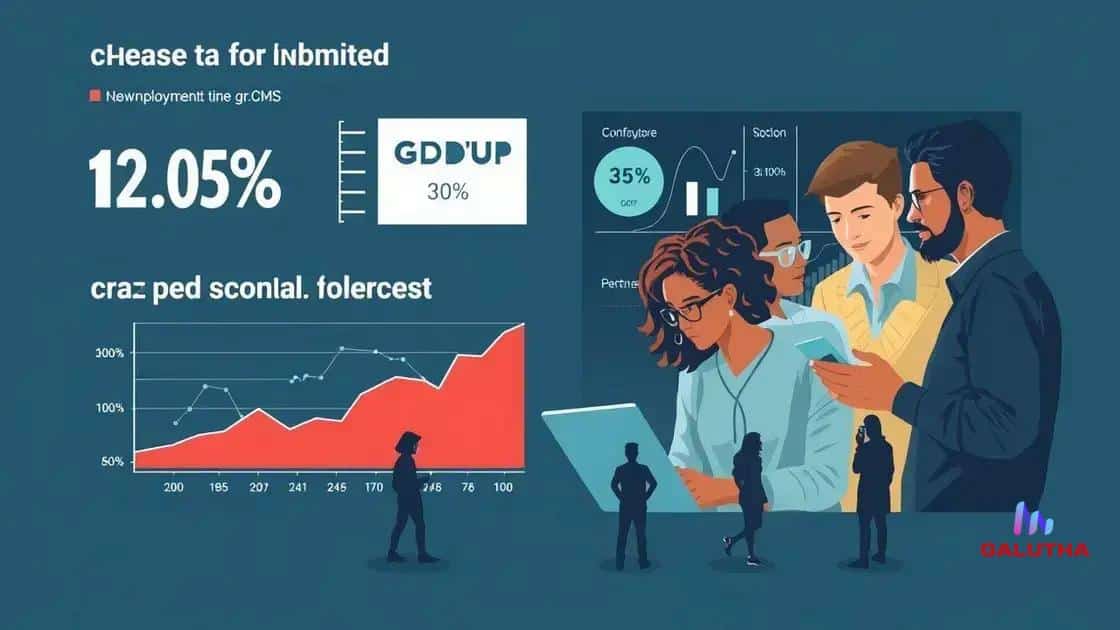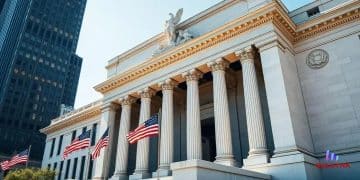Global economic slowdown concerns: what you need to know
Global economic slowdown concerns are marked by key indicators like rising unemployment, decreased GDP, and lower consumer confidence, prompting individuals and businesses to adapt strategies for financial stability and recovery.
Global economic slowdown concerns are increasingly on the minds of investors and consumers alike. But what exactly does this mean for you? Let’s explore the implications and possible strategies to adapt.
Understanding the global economic slowdown
Understanding the global economic slowdown is essential for anyone navigating the complex landscape of today’s economy. This phenomenon affects individuals, businesses, and governments all around the world.
What Causes a Global Economic Slowdown?
Several factors contribute to a global economic slowdown. Some of the most significant include:
- Decreased consumer spending: When people become more cautious about their finances, they tend to spend less, which can hurt businesses.
- Trade tensions: Disputes between countries can lead to tariffs and other barriers that inhibit trade.
- Interest rate changes: Central banks may raise rates to control inflation, impacting borrowing and investment.
These factors often intertwine, creating a cycle that can be difficult to break. For instance, when consumer spending decreases, businesses may cut back on hiring or investment, further slowing the economy.
Impact on Different Sectors
The effects of a global economic slowdown vary across different sectors. For instance, manufacturing and exports often take a big hit. Many companies may face declining orders, leading to reduced output.
Similarly, the retail sector often feels the pinch as customers prioritize essentials over luxuries. Service industries, such as tourism and entertainment, can also suffer as people cut back on discretionary spending.
Despite the challenges, some sectors may still find opportunities. Companies with strong online presences, for example, can thrive as more people shop from home. Innovation often flourishes in tough times, prompting businesses to adapt and evolve.
How Can Individuals Prepare?
During a global economic slowdown, individuals can take steps to safeguard their finances:
- Emergency savings: Building a financial cushion can provide peace of mind and stability.
- Skills development: Investing in education or new skills can enhance job security and opportunities.
- Budgeting: Keeping a close eye on spending can help maintain financial health during uncertain times.
In understanding a global economic slowdown, it’s important to stay informed and adaptable. Keeping a positive mindset while preparing for potential challenges can make a significant difference during these times.
Key indicators of economic decline

Identifying the key indicators of economic decline can help individuals and businesses prepare for challenging times. These indicators reveal signs of slower growth and potential downturns.
Unemployment Rate
The unemployment rate is one of the most visible signs of a slowing economy. A rise in unemployment often indicates that companies are cutting jobs due to reduced demand for goods and services.
When people lose their jobs, spending decreases, leading to further economic issues. Understanding this connection is essential for recognizing the broader impacts of a global economic slowdown.
Gross Domestic Product (GDP)
GDP measures the total value of goods and services produced in a country. A declining GDP over two consecutive quarters typically signals an economic recession.
- Monitoring GDP can provide insights into the overall health of the economy.
- A decreasing GDP may affect innovation and investments.
- Countries may respond with policy adjustments, such as lowering interest rates.
Changes to GDP can signal shifts that impact businesses, consumers, and governments alike. For example, a sudden slowdown in GDP may lead to increased caution among investors.
Consumer Confidence Index
The Consumer Confidence Index reflects how optimistic or pessimistic consumers feel about the economy. When consumers are confident, they are more likely to spend money, boosting the economy.
However, when the index drops, it suggests that people are worried about their financial futures. This shift can lead to decreased spending, making the economic environment more challenging.
Tracking these indicators can provide valuable information about potential economic declines. By understanding the shifts in employment, production, and consumer sentiment, individuals and businesses can adapt their strategies accordingly.
Sectors most affected by slowdown
The sectors most affected by a slowdown can provide vital insights into where economic challenges are most pronounced. Different industries react to economic fluctuations in unique ways, and understanding these reactions can help individuals and businesses make informed decisions.
Manufacturing and Industry
Manufacturing is often at the forefront of a slowdown. When demand for goods decreases, manufacturers may face excess inventory, which leads to reduced production. This cut in output can result in layoffs and decreased worker hours.
- Supply chain disruptions: Slowdowns can lead to delays and increased costs.
- Investment cuts: Companies may halt or reduce capital expenditures.
- Focus on efficiency: In an attempt to survive, businesses might prioritize cost-cutting measures.
As the manufacturing sector decreases output, it often creates a ripple effect across the economy, impacting jobs and spending in related fields.
Retail
The retail sector frequently experiences the effects of an economic slowdown as consumers become more cautious with their spending. Retailers may see drops in foot traffic and online sales, which can lead to store closures and job losses.
Consumers typically prioritize essentials over luxury items during tough economic times, leading to shifts in inventory and marketing strategies. Many retailers may also resort to discounts and sales to move stock, which can affect profit margins.
Travel and Tourism
The travel and tourism industry is highly sensitive to economic changes. When disposable incomes fall, people often cut back on travel plans, leading to declines in hotel bookings and airfare.
Tourism boards may need to adjust their strategies by promoting local attractions or discounts to attract tourists. As a result, this sector can see significant fluctuations based on economic health.
By understanding which sectors are most affected by a slowdown, individuals can better navigate challenges. Keeping an eye on these industries can provide a glimpse into broader economic trends and potential impacts on employment and consumer behavior.
Strategies for individuals during economic downturns
During economic downturns, having effective strategies in place can help individuals weather the storm. Understanding these strategies is crucial for financial stability and peace of mind.
Building an Emergency Fund
One of the best strategies is to establish a financial safety net. An emergency fund can cover unexpected expenses, such as medical bills or car repairs, during tough times.
- Start small: Aim for a few hundred dollars and gradually build it up.
- Keep it accessible: Use a savings account that is easy to access in case of emergencies.
- Aim for three to six months: Ideally, save enough to cover three to six months of living expenses.
This fund provides security and allows individuals to face economic challenges without significant stress.
Budgeting Wisely
Creating and sticking to a budget is vital during an economic slowdown. By monitoring income and expenses, individuals can make informed financial decisions.
Prioritize necessities over wants. Focus on essentials such as housing, groceries, and healthcare. Understanding spending habits can reveal areas to cut back, helping to stretch finances further.
Investing in Skills
Another effective strategy is to invest in personal development. Learning new skills can enhance employability and open up new job opportunities.
Consider online courses or certifications that can be completed on a flexible schedule. This approach not only builds confidence but also prepares individuals for a more competitive job market.
Strong networking can also offer support during tough times. Connecting with peers or industry professionals can lead to new opportunities and shared advice.
By implementing these strategies, individuals can better navigate through a downturn. Being proactive can lead to greater financial resilience in challenging times.
Looking ahead: recovery prospects
Looking ahead, the prospects for recovery from a global economic slowdown are crucial for businesses and individuals alike. Awareness of potential recovery paths can provide hope and guide planning.
Economic Indicators to Watch
As we anticipate recovery, several key indicators will help gauge economic health. Monitoring these can give insights into how quickly the economy may bounce back.
- GDP Growth: A return to positive GDP growth signals a recovering economy.
- Job Creation: Rising employment numbers often indicate increased business confidence and consumer spending.
- Consumer Spending: When consumers start to spend freely again, it usually hints at recovery.
These indicators can help individuals and businesses adjust their strategies in response to changing economic conditions.
Government Policies and Stimulus Measures
Governments play a significant role in fostering recovery during an economic downturn. Policies aimed at stimulating growth can include:
- Monetary Policy Adjustments: Lowering interest rates can encourage borrowing and investment.
- Fiscal Stimulus: Increased government spending on infrastructure and services can create jobs and boost demand.
- Support for Small Businesses: Tailored assistance, such as grants or loans, can help vulnerable industries survive and thrive.
Such measures can create a foundation for a solid recovery, directly impacting individuals and communities.
Adapting to New Market Trends
Post-recovery, market landscapes may significantly shift. Many businesses will need to adapt to these changes to succeed. This can mean embracing technology or reevaluating business models to align with new consumer behaviors.
For example, the increase in remote work may lead to a higher demand for home office supplies or tech services. Businesses that can pivot quickly and effectively will place themselves in a strong position for growth.
While uncertainty remains during such transitions, clear recovery prospects offer a pathway forward. By staying informed and adaptable, individuals and businesses can better navigate the changes ahead.
FAQ – Frequently Asked Questions about Economic Slowdowns
What are some key indicators of an economic slowdown?
Key indicators include rising unemployment rates, decreasing GDP, and lower consumer confidence.
How can I prepare financially during an economic downturn?
Building an emergency fund and creating a detailed budget can help you manage expenses effectively.
What sectors are most affected by economic slowdowns?
Manufacturing, retail, and travel industries often face significant challenges during economic downturns.
How can individuals contribute to economic recovery?
By supporting local businesses, investing in personal development, and staying engaged in their communities, individuals can help stimulate recovery.





